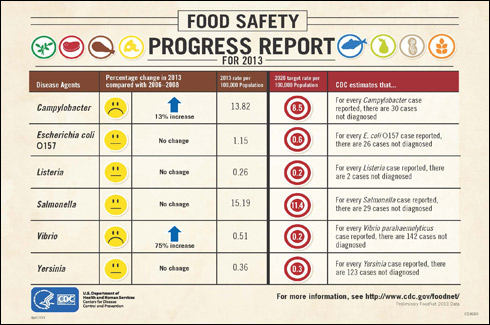CDC: 2013 data show limited progress in reducing foodborne infections
Click Here to Manage Email Alerts
Rates of some foodborne illnesses have been on the rise in recent years, according to the CDC’s food safety progress report for 2013.
There has been a 13% increase in foodborne illnesses related to Campylobacter since 2006-2008, and a 75% increase in Vibrio infections, the highest rate observed since 1996, according to the report. However, the rate of infections caused by Vibrio vulnificus, considered the most severe Vibrio species, has remained steady. There has been no change in the rates of infections caused by Escherichia coli O157, Listeria or Yersinia since 2006-2008.
For Salmonella, the rate of infection decreased by 9% compared with the 2010-2012 time period, returning to the rate observed at the 2006-2008 baseline period. The decline since 2010-2012 may be attributed to halting a large outbreak in 2010 related to eggs, and the subsequent increased regulations on the egg industry, according to Robert Tauxe, MD, MPH, deputy director of CDC’s division of foodborne, waterborne and environmental diseases.
“This year’s data show some recent progress in reducing Salmonella rates, and also highlight that our work to reduce the burden of foodborne illness is far from over,” Tauxe said during a media briefing. “To keep Salmonella on the decline, we need to work with the food industry and our federal, state and local partners to implement strong actions to control known risks and to detect foodborne germs lurking in unsuspected foods.”

Source: CDC
In 2013, the Foodborne Diseases Active Surveillance Network (FoodNet) logged more than 19,000 infections, 4,200 hospitalizations and 80 deaths from the nine pathogens it tracks. The groups most affected by foodborne illness include children younger than 5 years and adults aged 65 years and older.
According to David Goldman, MD, MPH, assistant administrator for the Department of Agriculture’s Food Safety and Inspection Service (FSIS) Office of Public Health, there have been regulations proposed to prevent food safety problems in many sectors, including produce farms, food facilities, food importers, food transporters and third-party auditors/certification bodies.
“Steps are underway to address many of the concerns raised in this report,” Goldman said. “As these actions are being implemented, we are beginning to see progress, and I am confident we will see further improvement over time.”
Stephen Ostroff, MD, the FDA’s acting chief scientist, said that these data highlight the importance of continuing preventive measures from the farm to the consumer.
“We are making significant progress in implementing the FDA Food Safety Modernization Act, having issued seven proposed rules addressing the safety of produce, imported foods and human and animal food production and transportation,” Ostroff said. “Full implementation of these rules will help prevent these types of infections.”
